
Corporate HR is essential in managing an organization's human resources to gain a competitive advantage. Proactive Corporate HR has several benefits, including reduced time between learning and application, focus on the present and future needs of the organization, reduced cost, increased organizational commitment, increased organizational learning, and concentration on both results and processes. The process for proactive Corporate HR involves training needs identification, planning, and implementation of training.
Introduction
Corporate HR in a Proactive Role
Challenges of the Business Environment
Benefits of Proactive Corporate HR
Reduce Time Between Learning and Application
Introduction: The business environment is constantly changing and becoming increasingly unpredictable due to the ever-evolving technology, globalization, cost containment, and market speed. As such, Corporate HR has a vital role in proactively managing an organization's human resources to gain a competitive advantage over its competitors. Corporate HR must identify the competencies required in employees, plan and suggest appropriate training methods, and ensure the implementation of the training.
Benefits of Proactive Corporate HR
Proactive Corporate HR has several benefits for an organization.
Firstly, it reduces the time between learning and application, as employees are trained in the specific skills they need to perform their tasks. This enables them to apply their knowledge to their work more quickly and efficiently.
Secondly, it focuses on the present and future needs of the organization, ensuring that the employees are equipped with the skills necessary to meet the changing demands of the business environment.
Thirdly, it reduces cost, as training is tailored to the organization's specific needs rather than generic training, which may not be relevant.
Fourthly, it increases organizational commitment, as employees are more likely to be engaged and motivated if they feel their skills are being developed and their needs are being met.
Fifthly, it increases organizational learning, as employees are more likely to share their knowledge and experiences if they feel their skills are being developed.
Finally, it allows the organization to concentrate on results and processes, as the training is tailored to its specific needs rather than focusing solely on results.
Process for Proactive Corporate HR
The process for proactive Corporate HR begins with training needs identification. This involves the different departmental heads and unit HR persons identifying the competencies required in employees. Once the training needs have been identified, Corporate HR then plans the training, which includes deciding on the training type, the training duration, and the resources required.
Finally, the implementation of the training is done by the unit HR person, who ensures that the employee is informed accordingly and that the movement is tailored to the organization's specific needs.
Conclusion: In conclusion, Corporate HR plays an essential role in proactively managing an organization's human resources to gain a competitive advantage over its competitors. The benefits of proactive Corporate HR include reduced time between learning and application, focus on the present and future needs of the organization, reduced cost, increased organizational commitment, increased organizational learning, and concentration on both results and processes.
The process for proactive Corporate HR begins with training needs identification, followed by the planning of the training, and finally, the implementation of the movement.
Proactive Corporate HR is the cornerstone of achieving competitive advantage in today's business world.

Frequently Asked Questions
What are the benefits of proactive corporate HR in achieving competitive advantage?
Any business's success mainly depends on its ability to attract, retain, and engage the best talent. Proactive corporate HR is critical in achieving this goal and has provided a competitive advantage for businesses. This article will discuss the benefits of proactive corporate HR and how it can help companies to gain a competitive advantage.
The first benefit of proactive corporate HR is that it can help to attract top talent. By creating an attractive workplace culture and providing competitive benefits packages, businesses can draw in the best candidates for available positions. Proactive HR can also help retain current employees, providing opportunities for career growth and development. This can help to create a loyal, dedicated workforce that is more likely to stay with the organization for the long term.
A second benefit of proactive corporate HR is that it can help to create a positive working environment. By providing a supportive work environment, businesses can ensure that employees are motivated and engaged. This can lead to increased productivity, which can positively impact the bottom line. Additionally, a positive work environment can help create a company culture attractive to potential employees.
Finally, proactive corporate HR can help ensure labor laws and regulations compliance. By staying current on the latest labor laws and regulations, businesses can ensure that they remain in compliance. This can help to avoid costly fines and penalties, which can hurt the bottom line.
In conclusion, proactive corporate HR can have several benefits for businesses. It can help to attract and retain top talent, create a positive work environment, and ensure compliance with labor laws and regulations. Ultimately, these benefits can help businesses to achieve a competitive advantage in the marketplace.
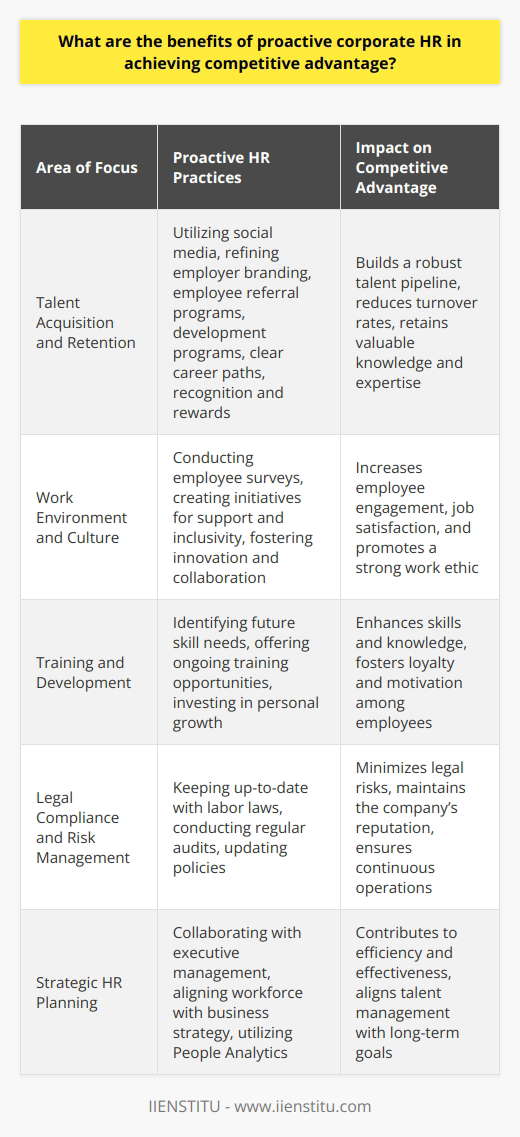
What is the process for implementing proactive corporate HR?
Employee engagement is essential for the success of any organization. As such, it is vital to implement proactive corporate HR practices to promote productivity and efficiency. Proactive corporate HR involves taking proactive steps to manage employee performance and foster motivation.
The first step in implementing proactive corporate HR is to identify the organization's current needs. This includes assessing the current employee engagement levels and identifying areas where improvements can be made. It is also essential to identify the skills and abilities of the current workforce, as this will help to determine the best HR practices to implement.
Once the organization's needs have been identified, developing a comprehensive HR strategy is essential. This strategy should include goals and objectives for employee engagement and specific tactics for achieving these goals. It is necessary to ensure that the strategy is aligned with the organization's overall mission and vision.
Once the HR strategy has been developed, it is essential to ensure that it is communicated to all employees. This can be done through various methods, such as email, flyers, and posters. It is also essential to ensure that employees have the necessary tools and resources to help them achieve the goals outlined in the HR strategy.
The next step in implementing proactive corporate HR is to implement the strategy. This includes ensuring that employees are engaged in the process and providing support and guidance when needed. It is also essential to provide regular feedback to employees to ensure the strategy is followed.
Finally, it is essential to review the HR strategy's effectiveness regularly. This can be done by assessing employee engagement levels and measuring the strategy's success. It is also necessary to ensure that the strategy is continually updated and improved to remain effective.
By following these steps, organizations can ensure that their HR strategies are implemented proactively and that their employees remain engaged and productive. By taking these steps, organizations can ensure that their employees are motivated and productive, resulting in increased organizational success.
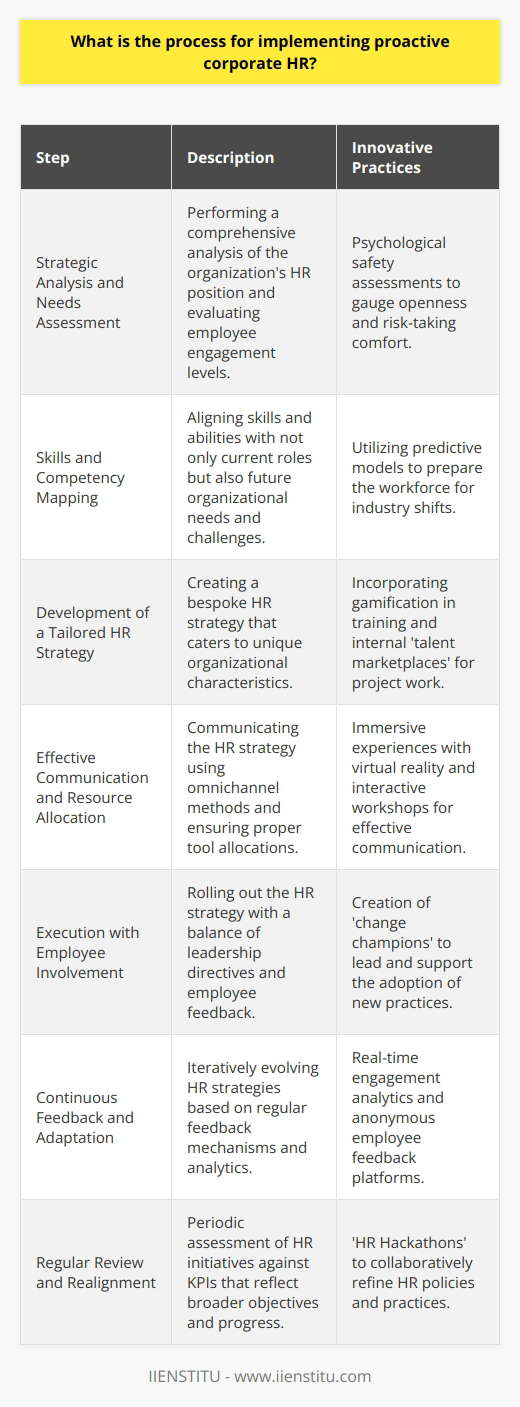
How can proactive corporate HR help reduce costs and increase organizational commitment?
Organizations are increasingly aware of the importance of corporate HR in helping reduce costs and increase organizational commitment among employees. Proactive corporate HR strategies can help organizations achieve these goals by providing employees with the tools and resources to become more productive, engaged, and committed to their work.
The role of corporate HR in cost reduction begins with the recruitment and selection process. Through effective recruiting techniques, organizations can identify potential employees who are well-suited to their roles and have the right qualifications. This can help reduce the cost of hiring and onboarding new employees. Additionally, corporate HR can help organizations make informed decisions about employee compensation and benefits, which can help reduce costs associated with payroll.
Proactive corporate HR can also help organizations increase organizational commitment among employees. Employees who are more engaged and motivated are more likely to be invested in their work and committed to the organization. Corporate HR can help by providing employees with the resources they need to be successful. This can include training and development opportunities, career guidance, job satisfaction surveys, and other initiatives that help employees build their skills and better understand their roles within the organization. Corporate HR can also help create a positive work environment through employee wellness programs, flexible working conditions, and recognition programs.
In conclusion, proactive corporate HR can help reduce costs and increase organizational commitment. To do this, organizations must recruit qualified candidates, provide employees with the resources and support they need, and create a positive workplace environment. By taking a proactive approach to corporate HR, organizations can ensure that their employees are engaged and committed to the organization’s success.
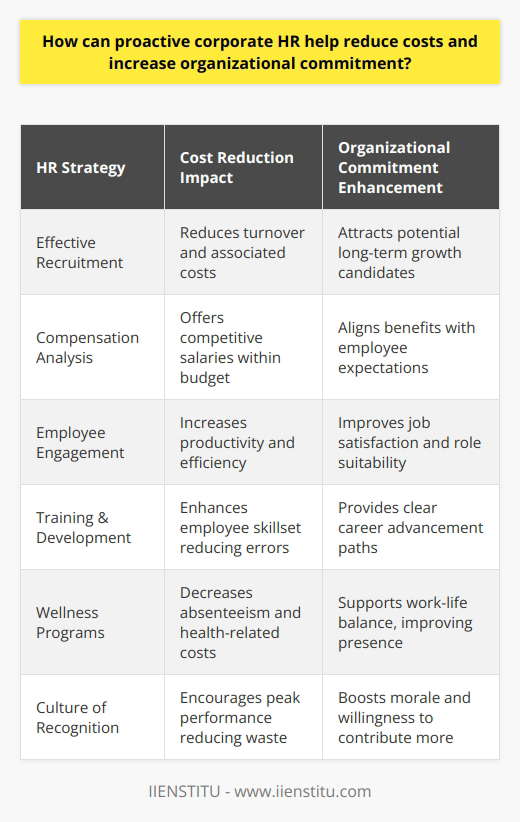
How do companies use HR to gain competitive advantage?
Leveraging HR for Competitive Advantage
**Strategic Workforce Planning**
Companies utilize HR strategically to gain a competitive edge by understanding their current workforce's capabilities and planning for future needs. This forward-looking approach helps organizations align their talent needs with organizational goals, enabling them to stay ahead of competitors who may not have the same talent pool.
**Talent Attraction and Retention**
The ability to attract and retain top talent is a significant determinant of a company's success. HR plays a critical role in this by developing and implementing employer branding and recruitment strategies, ensuring that potential candidates view the company as an attractive place to work. Moreover, HR designs employee benefits and compensation packages, as well as learning and development opportunities, which help with retaining employees in the long run.
**Performance Management**
A company's competitive advantage is enhanced when its employees perform at their best. HR facilitates this by implementing effective performance management systems that facilitate regular feedback, set clear performance expectations, and provide employees with vital resources and support. In turn, this drives high performance among employees, leading to tangible business results that surpass competitors.
**Workforce Analytics**
Companies can use workforce analytics to identify patterns and trends in employee performance, predict staffing requirements, and inform talent management decisions. By leveraging data-driven insights, HR can more effectively align their initiatives with business objectives, thus contributing to an organization's competitive advantage. For example, analyzing employee engagement levels can inform strategies tailored to improving morale and productivity.
**Creating a Culture of Innovation**
HR professionals aid in establishing an organizational culture that fosters innovation and learning, both of which are key drivers of competition. By promoting a culture that values open communication, continuous improvement, and adaptability, HR helps create an environment where employees can innovate and collaborate more effectively. This, in turn, enables companies to better respond to market trends and anticipate customer needs, thus outperforming their competition.
In conclusion, companies use HR to gain a competitive advantage by initiating strategic workforce planning, attracting and retaining top talent, managing employee performance, leveraging workforce analytics, and fostering a culture of innovation. These efforts enable organizations to stay ahead of competition by utilizing their most valuable resource, their people.

What is a proactive strategy for HR and how does it contribute to an organization's success?
Proactive HR Strategy Defined
A proactive strategy for human resources (HR) involves anticipating potential workforce, organizational culture, and talent management challenges before they emerge, and implementing measures to address them effectively. By adopting this forward-thinking approach, HR professionals can optimize talent acquisition and development processes, as well as help an organization achieve its strategic goals.
Impact on Talent Acquisition
Successful talent acquisition is crucial to establishing a highly competitive and productive workforce. A proactive HR strategy contributes to this by identifying future skills requirements and creating targeted recruitment campaigns to attract and retain top talent. Additionally, a strong focus on employer branding can position an organization as an employer of choice, ensuring a robust pipeline of qualified candidates for existing and future vacancies.
Enhancing Employee Development
Continuous employee development is integral to organizational success. Proactive HR involves offering employees ample opportunities for professional growth through well-defined career paths, ongoing training, and development programs. By mapping out advancement opportunities and upskilling initiatives, HR professionals empower employees to grow within the organization, ultimately fostering retention, boosting engagement, and strengthening the company's overall performance.
Effective Performance Management
A proactive HR strategy takes performance management beyond traditional annual appraisals, incorporating continuous feedback systems and regular check-ins. This approach enables managers to promptly identify and address performance-related issues, thereby maintaining workforce productivity and nurturing a culture of accountability. It also allows HR professionals to align employee goals with organizational objectives, ensuring that individual and team aspirations contribute to overall business success.
Promoting Diversity, Equity, and Inclusion
Organizations that prioritize diversity, equity, and inclusion (DEI) often reap tangible benefits, such as increased innovation, improved employee satisfaction, and a broader talent pool. A proactive HR strategy must prioritize DEI in recruiting and retaining employees, designing policies and practices that foster a positive and inclusive workplace culture. By cultivating an environment that values diverse perspectives and experiences, HR can contribute significantly to an organization's overall success.
Facilitating Organizational Agility
The rapidly changing business landscape necessitates organizational agility to survive and thrive. Proactive HR strategies contribute to organizational success by foreseeing disruptions and changes in the industry, and developing plans to respond to these challenges. HR professionals can help organizations adapt by facilitating frequent workforce planning, creating adaptable job roles, and developing a robust internal labor market.
In summary, a proactive HR strategy is essential in forging an organization's long-term success. By focusing on effective talent acquisition, employee development, performance management, DEI, and organizational agility, HR professionals can foster sustained growth and resiliency in a dynamic business environment.

In what ways can proactive HR management practices lead to a more engaged and efficient workforce?
Proactive HR Strategies
To foster an engaged and efficient workforce, it is crucial for organizations to implement proactive HR management practices. These practices involve various approaches, such as prioritizing employee well-being, promoting regular communication, and encouraging continuous learning and development. By incorporating these strategies, companies can enhance their overall work environment and boost productivity.
Prioritizing Employee Well-Being
A critical aspect of proactive HR management is prioritizing employee well-being. By offering comprehensive health benefits, flexible work schedules, and generous paid time off policies, employers can help employees maintain a healthy work-life balance. This, in turn, leads to increased job satisfaction and heightened commitment, resulting in a more engaged and efficient workforce.
Promoting Regular Communication
Open and regular communication is vital for employee engagement. Proactive HR management practices promote the exchange of ideas and feedback by creating channels for open dialogue between employees and management. Through regular employee surveys and feedback sessions, HR managers can gather valuable insights to address concerns and implement improvements, leading to a more motivated and productive workforce.
Encouraging Continuous Learning and Development
Investing in employee learning and development is a key aspect of proactive HR management. By providing employees with opportunities to attend training programs, workshops, and conferences, companies can help them acquire new skills and stay updated with industry trends. This commitment to continuous learning fosters a culture of growth and innovation within the organization, resulting in a more capable and efficient workforce.
Recognizing and Rewarding Achievements
Recognizing and rewarding employee achievements is essential for a high-performance work environment. Proactive HR practices involve implementing performance-based incentives, such as bonuses, promotions, and non-monetary rewards, to acknowledge hard work and accomplishments. This recognition not only motivates employees to perform better but also fosters a sense of belonging and loyalty towards the organization, leading to a more engaged workforce.
Fostering Inclusivity and Diversity
Proactive HR management strives to create an inclusive and diverse work environment. By promoting equal opportunities and embracing diverse perspectives, companies can enhance employee engagement and stimulate innovation. Inclusive HR practices, such as ensuring unbiased recruitment processes, offering equal growth opportunities, and addressing employee concerns, help create a more productive and efficient workforce.
In conclusion, proactive HR management practices contribute significantly to the development of an engaged and efficient workforce. By prioritizing employee well-being, promoting open communication, encouraging continuous learning, recognizing achievements, and fostering inclusivity, organizations can create a high-performance work environment and improve overall productivity.
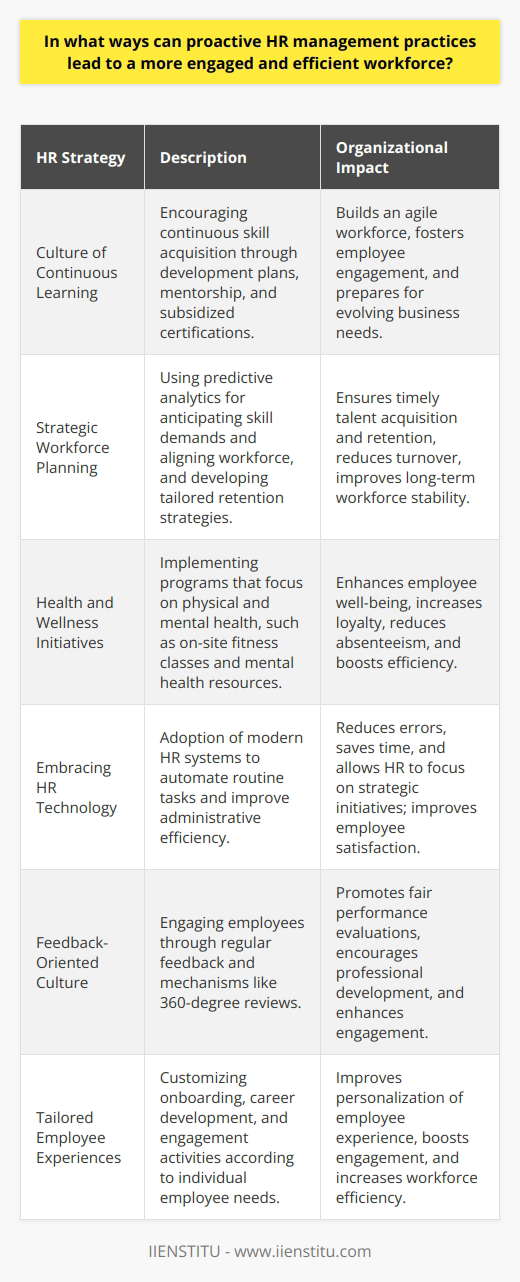
How does a proactive HR strategy relate to talent retention and development in the pursuit of gaining a competitive advantage?
Role of Proactive HR Strategy in Talent Retention and Development
A proactive HR strategy plays a significant role in talent retention and development by anticipating different aspects of the organization that need improvement, aligning business objectives with the skillset of employees, and fostering an environment that encourages growth and learning. By doing so, it allows the company to secure a competitive advantage in its respective industry.
Focus on Employee Engagement
When HR professionals engage in proactive measures, they identify the means through which employee engagement can be enhanced. A high level of employee engagement contributes to better retention of top talent, as satisfied and motivated employees are less likely to leave the organization for better opportunities elsewhere. Furthermore, engaged employees actively work towards developing their skills and expertise, aiding the organization in staying competitive in the rapidly changing business landscape.
Skill Development Training
To ensure the workforce remains adept to handle the challenges of the industry, a proactive HR strategy may include targeted skill development training programs. By pinpointing the areas where employees need further development, the organization can invest in tailor-made solutions to bridge the skill gap. As employees continuously refine their abilities, they become more valuable to the company, ultimately enhancing the organization's competitive advantage.
Continuous Feedback and Communication
Proactive HR strategies also facilitate transparent and continuous feedback between employees and management. Regular feedback helps employees understand their strengths and areas for improvement, which in turn aids in their development. Additionally, effective communication drives innovation and promotes a culture of collaboration, enabling the organization to maintain a competitive edge.
Employee Recognition Programs
By incorporating employee recognition programs into an HR strategy, companies acknowledge and reward their high-performing employees, promoting the retention of crucial talent. Recognizing individual and team accomplishments fosters a sense of appreciation, resulting in increased loyalty and overall job satisfaction. In turn, satisfied employees actively contribute to the company's growth and success.
In conclusion, a proactive HR strategy provides the organization with the necessary tools to retain and develop its workforce, which is critical in gaining a competitive advantage. By focusing on employee engagement, skill development training, continuous feedback and communication, and employee recognition programs, a company can secure its position as an industry leader and navigate disruptive market conditions successfully.
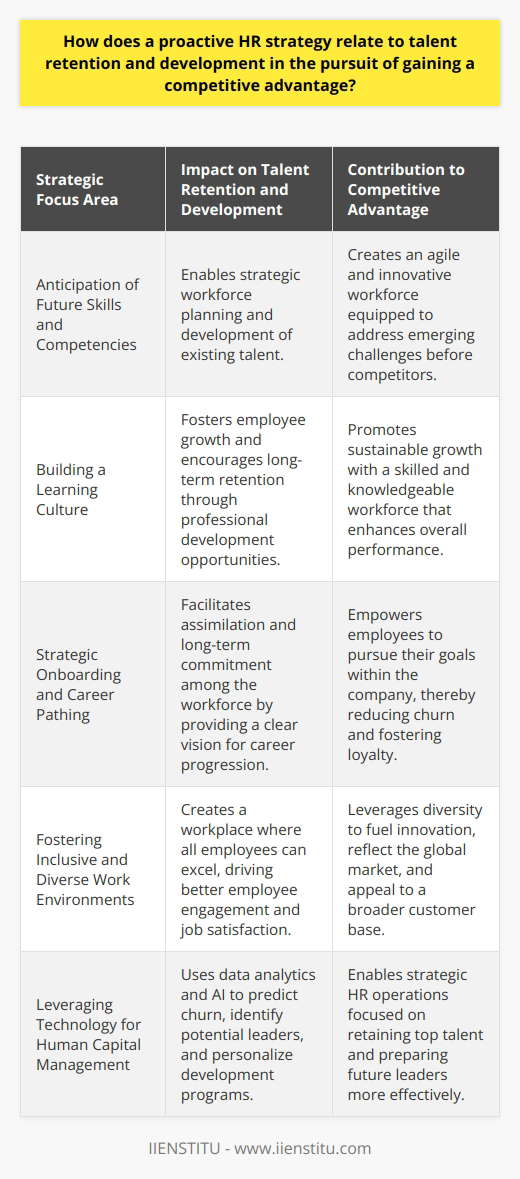
What are the key factors to consider when developing and implementing a proactive HR strategy to enhance an organization's competitiveness?
Understanding Organizational Needs
To develop and implement a proactive HR strategy that enhances an organization's competitiveness, it is crucial to first understand the organization's needs, objectives, and industry trends. Conducting a thorough workforce analysis can reveal gaps within the existing workforce, such as skill shortages and potential turnover risks, enabling HR professionals to proactively address these issues.
Creating a Talent Pipeline
A key factor in ensuring sustainability and competitiveness is the establishment of a talent pipeline. An effective talent management strategy involves not only attracting skilled employees through competitive recruitment practices, but also developing and retaining them through well-designed training and development initiatives. This approach helps organizations maintain a high level of employee engagement, foster an innovative work culture, and reduce turnover costs.
Aligning HR Strategy with Business Goals
An HR strategy must be closely aligned with the overall business strategy to effectively contribute to an organization's competitiveness. This involves understanding the company's objectives and tailoring HR practices, such as performance management and reward systems, to promote behaviors that advance these goals. Strategic HR partnerships with business units can help facilitate this alignment and ensure consistent execution.
Embracing Technological Advancements
Leveraging technology is an essential aspect of implementing a proactive HR strategy. By adopting advanced HR technology solutions, such as recruitment software, performance analytics tools, and learning management systems, organizations can improve efficiency, maximize resource allocation, and enhance decision-making capabilities. Such tools enable HR professionals to better anticipate and respond to future talent needs, thus providing a competitive advantage.
Fostering a Culture of Innovation
In today's rapidly evolving business landscape, fostering a culture of innovation is essential for long-term organizational success. Creating an environment where employees feel empowered to take risks and pursue new ideas is a vital component of a proactive HR strategy. By developing a culture that encourages creativity and experimentation, organizations can better adapt to changing market conditions and maintain a competitive edge.
In conclusion, by understanding organizational needs, creating a talent pipeline, aligning HR strategy with business goals, embracing technological advancements, and fostering a culture of innovation, organizations can successfully develop and implement a proactive HR strategy. This ultimately contributes to enhanced competitiveness and long-term success.
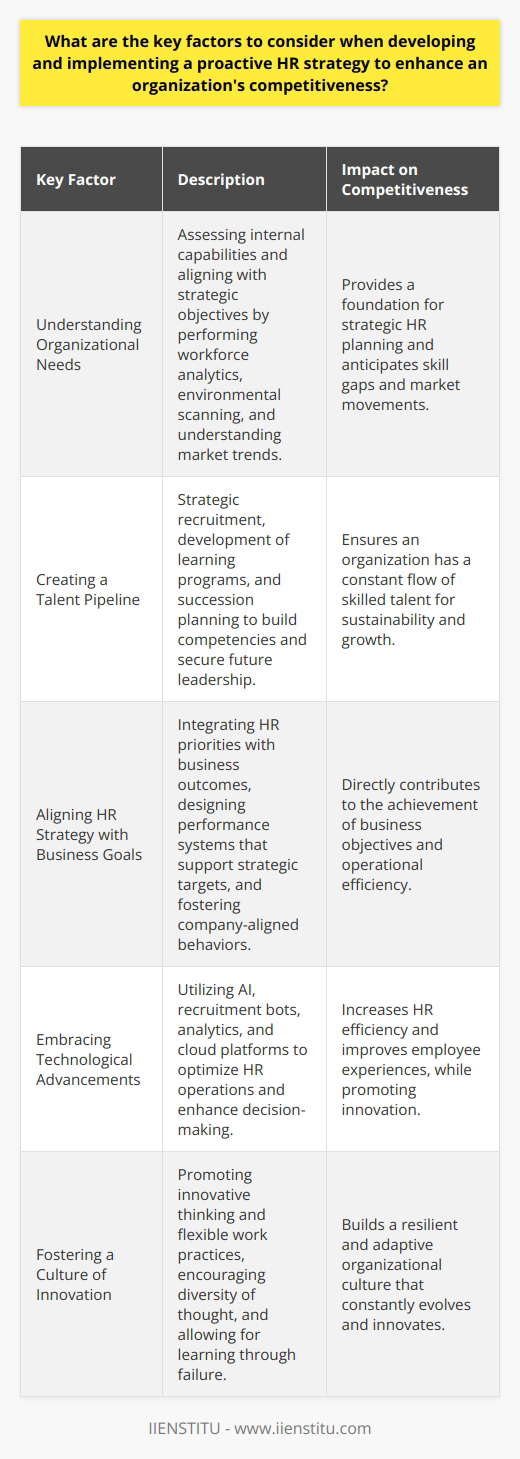
How can an organization measure the impact of proactive HR practices on its overall performance and competitive advantage?
Measuring Impact through Key Performance Indicators
Organizations can measure the impact of proactive HR practices on overall performance and competitive advantage by utilizing key performance indicators (KPIs). These quantifiable measures help to determine the effectiveness of HR initiatives in achieving desired outcomes. Examples of relevant KPIs include employee engagement, turnover rates, and the time it takes to fill open positions.
Examining Employee Engagement
One specific KPI for assessing the impact of proactive HR practices is employee engagement. Higher levels of engagement result in improved productivity, loyalty, and a greater sense of satisfaction among employees. Conducting periodic surveys, monitoring employee feedback, and analyzing performance data can provide insights into the success of HR efforts in fostering an engaged workforce. Enhanced engagement can ultimately lead to better overall performance and increased competitiveness within the organization’s industry.
Evaluating Turnover Rates
Another relevant KPI for assessing the effect of proactive HR practices is turnover rates. Reducing employee attrition is essential for maintaining a knowledgeable and skilled workforce. By monitoring employee departures and retention rates, organizations can determine if their HR initiatives are minimizing turnover effectively. Lower turnover rates can translate into reduced recruitment and training costs, contributing to an organization’s competitive advantage.
Analyzing Time to Hire
Lastly, measuring the time it takes to fill open positions is another valuable KPI for evaluating proactive HR practices. A streamlined and efficient hiring process can lead to reduced opportunity costs and improved quality of hire. Organizations can assess the effectiveness of their recruiting strategies by monitoring the time-to-hire metric, which can influence both overall performance and competitive advantage by optimizing workforce resources.
In conclusion, organizations can measure the impact of proactive HR practices on overall performance and competitive advantage by closely examining key performance indicators such as employee engagement, turnover rates, and time to hire. Regular monitoring and evaluation of these KPIs allow organizations to adjust their HR strategies accordingly and continuously improve their workforce, which in turn boosts their overall performance and competitive standing within their industry.

What are the key components of a proactive HR strategy that can drive competitive advantage?
Understanding Proactive HR Strategy
A proactive HR strategy is crucial in enhancing an organization's competitive advantage by addressing potential issues before they escalate and aligning human resources with business goals. The key components of a proactive HR strategy that can drive competitive advantage include workforce planning, talent management, employee engagement, analytical approach, and continuous improvement.
Workforce Planning
Effective workforce planning ensures that an organization has the right talent in place to achieve its strategic objectives. This involves forecasting the number, type, and skills of employees needed, identifying potential talent gaps, and implementing strategies to address these gaps through recruitment, training, and development programs.
Talent Management
Talent management focuses on attracting, developing, and retaining high-performing employees who can contribute significantly to business success. This includes creating compelling employer branding, providing competitive compensation packages, offering career advancement opportunities, and recognizing outstanding performance. By focusing on talent management, organizations can maintain a competitive edge by attracting and retaining top talent.
Employee Engagement
Actively promoting employee engagement is essential for maximizing productivity, increasing job satisfaction, and reducing turnover rates. Employee engagement strategies include effective communication, involvement in decision-making, provision of resources and support, work-life balance initiatives, and performance feedback. A highly engaged workforce is more likely to participate in continuous improvement and innovation, driving competitive advantage.
Analytical Approach
Leveraging data-driven insights to make informed HR decisions is a vital component of a proactive HR strategy. By employing HR analytics, organizations can identify workforce patterns and trends, predict future challenges, and evaluate the effectiveness of HR initiatives. Analytics can also help identify areas of improvement, enabling organizations to adopt more effective practices and achieve superior performance.
Continuous Improvement
A proactive HR strategy encourages a culture of continuous improvement, where HR processes and strategies are regularly reviewed and refined based on current needs and required outcomes. By proactively identifying areas for improvement, mitigating risks, and adjusting HR practices to align with changing business objectives, organizations can maintain their competitive advantage in the marketplace.
In summary, a proactive HR strategy is an essential driver of competitive advantage by ensuring the right workforce is in place, managing talent effectively, fostering employee engagement, adopting an analytical approach, and promoting continuous improvement. By implementing these key components, organizations can navigate through evolving business environments and improve their overall performance.
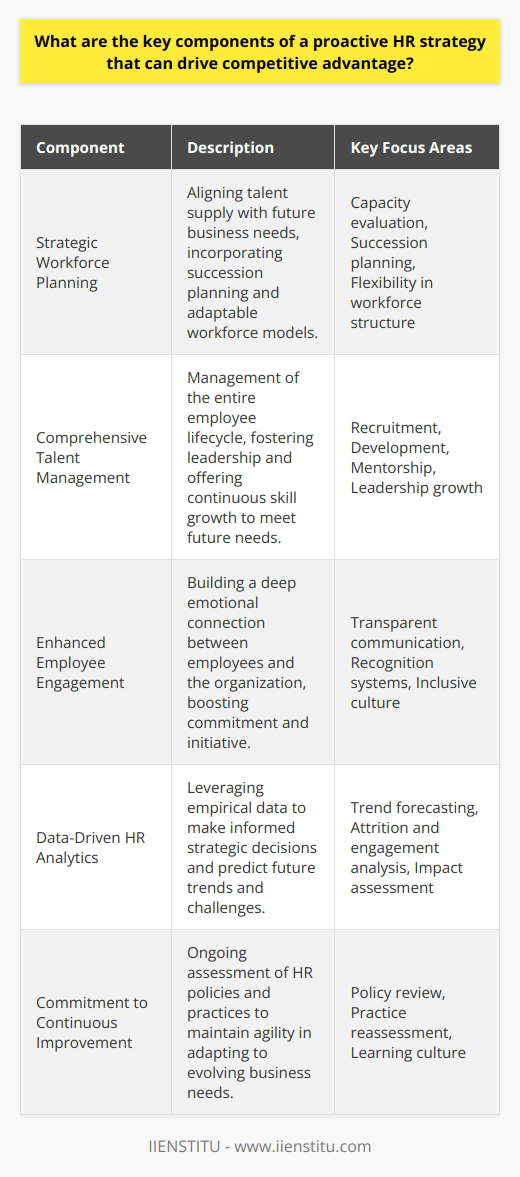
How can organizations effectively align their HR processes and practices with their broader strategic objectives to achieve a sustainable competitive advantage?
Organizational Alignment with Strategy
Organizations can effectively align their HR processes and practices with strategic objectives by incorporating a systematic approach. The critical components of this approach include assessing human capital, developing HR strategies, and continuous improvement.
Assessing Human Capital
The primary step in aligning HR processes with strategic objectives is to assess the organization's human capital. This involves examining employee capabilities, proficiencies, and potential. By understanding the workforce's strengths and weaknesses, HR can identify gaps in skills and knowledge that may obstruct achieving strategic goals.
Developing HR Strategies
Once the assessment of human capital is complete, organizations need to develop HR strategies that align with their broader strategic objectives. These strategies may include:
Talent Acquisition: Enhancing recruitment processes to attract candidates with requisite skills and aligning them with long-term goals of the organization.
Performance Management: Implementing effective appraisal systems to measure employee performance and align it with strategic targets.
Learning and Development: Designing training programs that fill skill gaps, enhance employee competencies, and support the overall business strategy.
Succession Planning: Identifying suitable candidates for key positions and developing them for future leadership roles to ensure organizational continuity.
Continuous Improvement
Aligning HR processes with strategic objectives is an ongoing process that requires monitoring and adjustments. Organizations should continuously evaluate their HR practices to ensure they remain congruent with evolving strategic goals. This can be done through analytics and feedback loops that measure the effectiveness of the implemented strategies. By identifying areas for improvement, HR can make informed decisions and adapt their processes.
In conclusion, organizations seeking a sustainable competitive advantage should integrate HR processes and practices with their broader strategic objectives. Through assessing human capital, developing HR strategies, and continuous improvement, organizations can optimize their workforce and ensure alignment with their overarching goals.
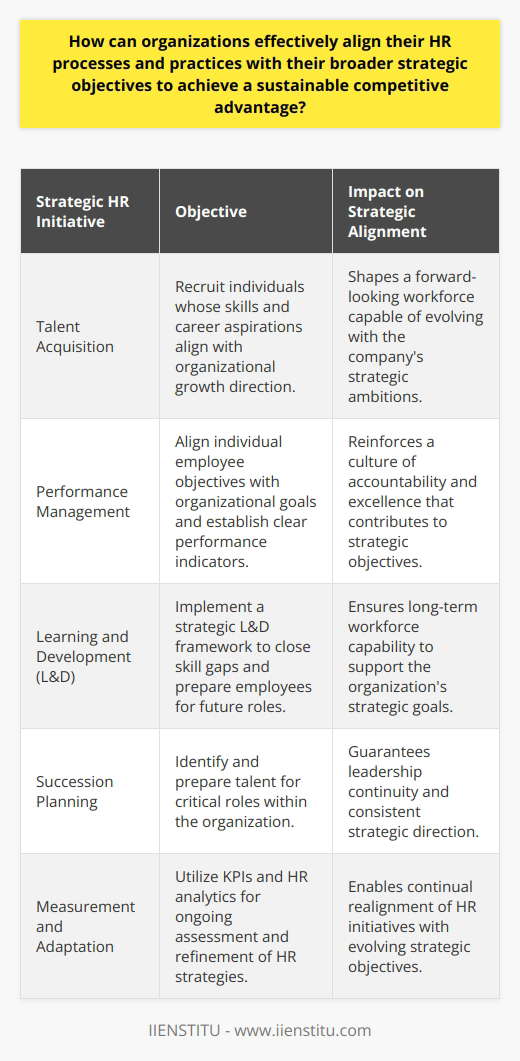
What role do technology and digital innovations play in enabling proactive HR strategies to maximize an organization's competitive advantage?
Role of Technology in HR Strategies
Digital innovations and technology have significantly transformed the human resource (HR) landscape. These advancements offer numerous benefits, leading to a more strategic, data-driven, and proactive approach in managing human capital.
Data-Driven Decision Making
One critical role of technology in HR is facilitating data-driven decision making. It enables HR professionals to make informed decisions by providing relevant and accurate data. For instance, HR analytics provides insights into workforce performance, talent acquisition, and employee engagement, thus allowing organizations to design strategies that enhance their competitive advantage.
Automation and Efficiency
Technology also streamlines HR processes through automation, reducing the time spent on repetitive tasks. This increased efficiency allows HR teams to focus on strategic roles such as talent management, leadership development, and organizational culture. By streamlining administrative tasks, organizations can reallocate resources towards proactive measures that foster a competitive edge.
Enhanced Employee Experience
Digital innovations have also redefined the employee experience. For example, advanced onboarding platforms can deliver tailored induction experiences, ensuring that new hires become effective team members quickly. Additionally, personalized learning platforms enable employees to constantly develop their skills, which in turn can increase an organization's competitiveness.
Virtual Collaboration and Communication Tools
The rise of remote work has necessitated new collaboration and communication tools. These innovations support and enhance virtual work environments, allowing teams to collaborate effectively regardless of their location. The ability to maintain optimal performance in remote work settings is crucial for organizations seeking a competitive advantage in a globalized economy.
Attracting and Retaining Talent
Finally, the use of digital tools in recruitment and talent management enables HR teams to attract top talent and retain employees. For instance, applicant tracking systems and AI-based recruitment solutions simplify the hiring process, while advanced retention strategies focus on employee well-being, incentives, and career growth.
Conclusion
Overall, technology and digital innovations play a vital role in enabling proactive HR strategies that maximize an organization's competitive advantage. By utilizing these tools, organizations can streamline processes, make informed decisions, enhance employee engagement, and foster a culture of continuous improvement. As a result, businesses that prioritize the integration of technology within their HR practices will emerge as industry leaders.
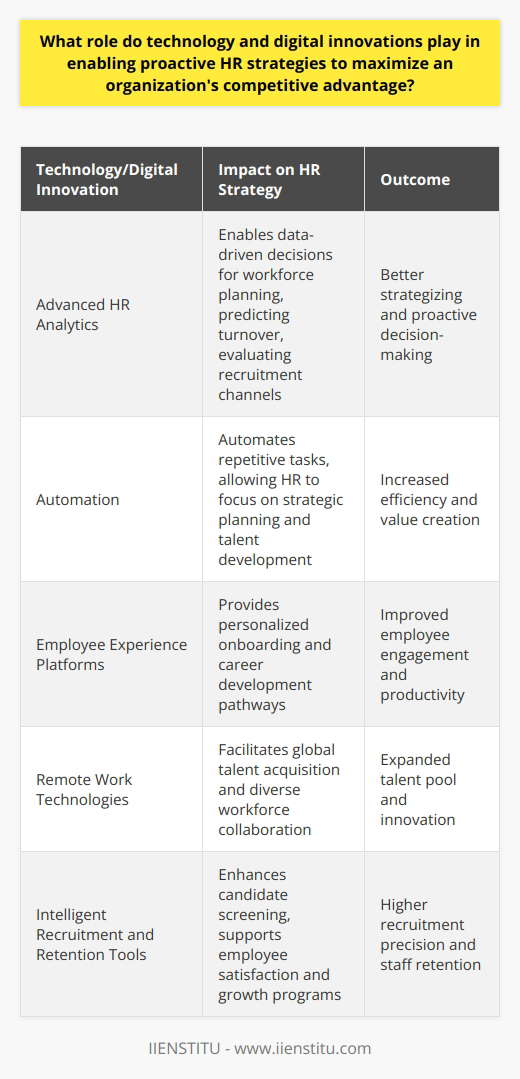
How do companies use HR to gain competitive advantage?
Talent Acquisition and Management
Companies use human resources (HR) to gain competitive advantage through talent acquisition and management. They hire skilled professionals to fulfill specific responsibilities. A proficient HR team ensures the right talent fills relevant positions.
Employee Training and Development
HR is essential for developing a workplace culture that supports lifelong learning. Using HR, companies train and upskill their workforce. By improving their employees’ skillsets, companies gain a competitive edge.
Performance Evaluation and Employee Retention
Firms utilize HR for performance appraisal and employee retention. Through performance evaluations, they identify their top performers and focus on retaining them. This approach bolsters their ability to stay ahead in the market.
Compensation and Benefits
Competitive salary packages and benefits, managed by HR, are crucial for acquiring and retaining top talent. Companies offering attractive compensation prove more successful in eliciting employee loyalty and dedication, facilitating a competitive advantage.
Diversity and Inclusion
A diverse workforce, fostered by HR, can provide a range of perspectives, facilitating improved problem-solving. Inclusion and diversity reflect positively on a company's reputation, enhancing its competitiveness.
Workforce Planning
HR assists businesses in strategic workforce planning. By aligning talent with business needs, they help organizations prepare for future challenges.
In conclusion, HR is not just about hiring or firing employees. Instead, it plays a significant role in equipping companies with a competitive edge in the business world.
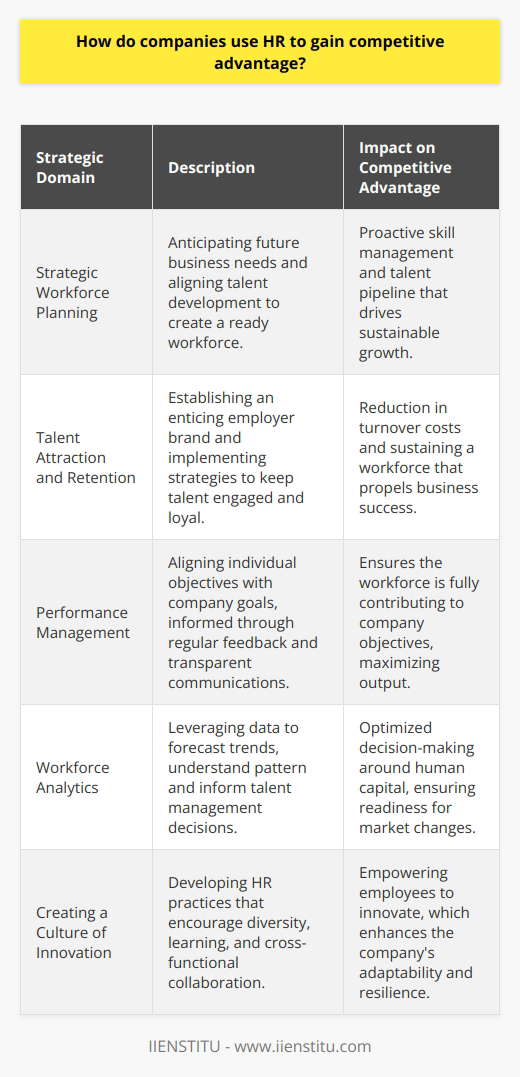
What is proactive HR strategy?
Proactive HR Strategy: Definition and Essence
A proactive HR strategy involves anticipating, predicting, and preparing for future needs related to human resources. Rather than being purely reactive, proactive HR takes a strategic approach.
Key Aspects of Proactive HR
Understanding this strategy involves acknowledging its core facets. It necessitates forecasting future business needs, planning for upcoming skill demands, and developing initiatives to meet those demands.
Anticipation and Planning
Foremost, proactive HR anticipates future workforce requirements. By analyzing emerging business trends, HR strategists predict necessary skills and competencies.
Preparation and Adaptation
Preparedness is crucial in proactive HR strategy. This concerns aligning employees' skills with future business needs, which may involve training or development programs.
Innovative HR Tools
In a proactive HR strategy, technology plays a pivotal role. Utilizing innovative HR tools aids in workforce management, talent assessment, and future-proofing the organization.
Importance of Proactive HR
A proactive HR strategy is essential for any organization desiring to cultivate a future-ready, skilled workforce. It offers a competitive advantage by preparing the organization for anticipated changes, thus ensuring business sustainability.
In conclusion, a proactive HR strategy demands anticipation, preparation, and adaptation to meet future HR needs. Utilizing innovative HR tools helps organizations to manage their workforce effectively, prepare for future changes, and maintain a competitive advantage. Thus, it plays a vital role in business growth and sustainability.

Why is being proactive important in HR?
Importance of Proactivity in HR
Proactive behavior within HR is an essential factor for organizational success. Proactive HR professionals foresee potential issues that may affect the organization and take steps to prevent them.
Forward-thinking Approach
This forward-thinking approach ensures smooth operations within the organization. It focuses on future problems, preparing the company beforehand and minimizing disruptions. This proactiveness can manifest in various ways such as executing new policies, providing training, and anticipating recruitment needs.
Enhancing Employee Engagement
Moreover, a proactive HR helps increase employee engagement and productivity. By addressing employee concerns even before they surface, HR can enhance job satisfaction. Regular feedback and actionable plans can remedy performance issues before they become significant.
Workforce Capability Building
Workforce planning is another area where proactivity is vital. Understanding the organization's future talent needs and tailoring strategies accordingly is proactive HR. This ensures that the company has the right talent at the right time, thereby driving business growth.
Legal Safeguard
HR’s proactive role is also protective in nature. Proactive HR professionals can foresee legal or regulatory changes that might affect the company. They anticipate these changes ahead of time, ensuring the company complies with new legislation.
To conclude, being proactive in HR ensures a well-functioning organization, engaged employees, and legal compliance, ultimately contributing to the company’s success. Thus, proactivity is a crucial trait in effective HR management.

